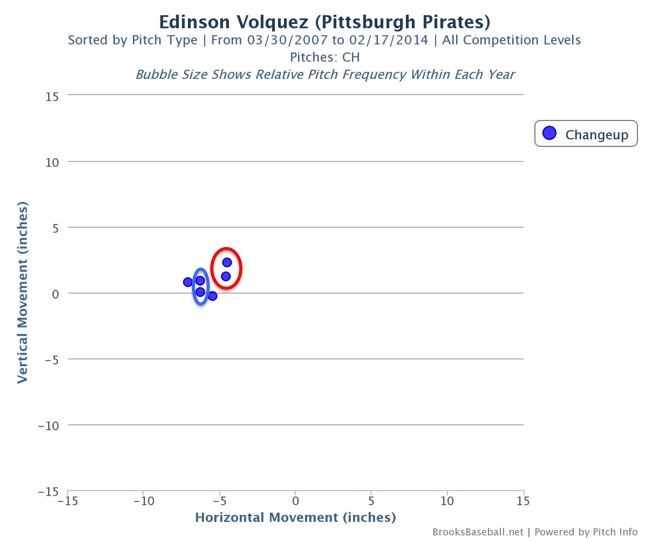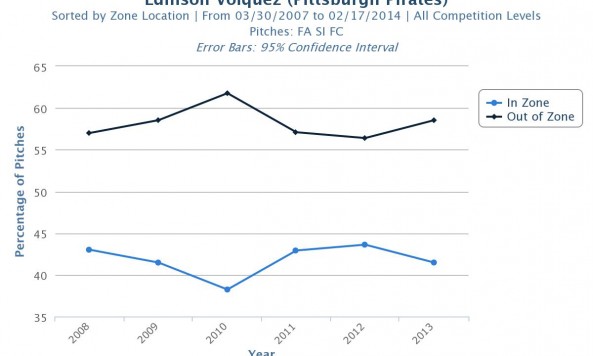Besides the lingering AJ Burnett situation, there's been one Pirate-related question that's been on my mind all winter: why on earth do the Pirates think Edinson Volquez is worth $5 million? I mean, I suppose if you go by wins above replacement there's a decent chance that Volquez will be worth somewhere around 1 WAR this year and that makes it an appropriate salary for the guy, but I'm not sure those odds are any better than the odds that Stolmy Pimentel or Jeff Locke or Brandon Cumpton will pitch at that level. You could have ten Pimentel/Locke/Cumptons for the price of one Volquez. The only reason for the Pirates to pay Edinson Volquez $5 million is that the team thinks that there's a chance that he'll be worth far more to them than $5 million.
You're likely familiar with the shape of Volquez's career to this point, but let's rehash it quickly here. Volquez was a decent prospect for the Rangers — he was Baseball America's #56 prior to the 2006 season, but he stumbled a bit in 2006 before finishing 2007 strong at Triple-A. That made him the main part of the Rangers' trade for Josh Hamilton after the 2007 season. Volquez quickly rewarded the Reds with a strong 2008 season; he was good enough that it looked for a while like the trade was more or less a wash. In that 2008 year, Volquez struck out 206 hitters in 196 innings. That and a 46% groundball rate was enough to make up for 93 walks and 14 hit batters. In 2009, he got off to a slow start and by June was on the disabled list with a Tommy John surgery in his near future. He didn't come back until July of 2010 and was pretty uneven due to control problems. He did make a dominant start against the Pirates (10 strikeouts, no walks, one hit in seven innings), but then the degree of difficulty against those 2010 Pirates was awfully low. He never really got back on track; in 2011 his walk rate went up to 5.4 BB/9 (or 13.3%, a career high either way) and the Reds traded him to the Padres that winter as part of the Mat Latos deal. He superficially improved (he had a 4.14 ERA) in 2012, but it seems safe to attribute a bunch of that to Petco Park. That's mainly because he lead the NL in walks and his other rates look pretty similar to his awful year in 2011. Last year he was disastrous for the Padres, to the point that they straight-up released him in August. The Dodgers picked him up for a handful of starts down the stretch, but were uninterested in bringing him back this winter
On the surface, it's easy to see how Volquez fits the Pirates' profile. He throws hard (his fastball averaged 93-94 every year except for last year, when it averaged ~92.5), he's got some sink on his fastball, and he throws a curveball as his primary breaking pitch. I don't like the comparison to Francisco Liriano so much, though; Liriano was legitimately dominant before his Tommy John surgery in 2006, and he had a great year in 2010. Volquez had one good year in 2008, and statistically it wasn't hugely different from the bad years that followed it. The obvious question to me is whether we can sift through the PitchFX data and find something that Volquez did or didn't do in 2008 that can be fixed by the Pirates in 2014. As a friendly reminder, all of these graphs were drawn up with the fantastically useful Brooks Baseball tool. I've included the links back to the Brooks page for all of the graphs; in most cases the original graphs will include some mouse-over data if you're interested in looking into things more deeply for yourself.
The first question is easy; Volquez's 2008 success seems to hinge on walking not quite as many batters as he has in the years since. We can make a graph of the percentage of his pitches that are in and out of the normalized strike zone in every season of his career (NOTE FOR CLARITY: I know the percentages look a little bit off here, but remember that the "zone" in question is a normalized one and that I'm drawing conclusions from the changes across time than from the specific percentages in any given year):
I don't think there's a whole lot to see here. Volquez's control, if we define it as a percentage of his pitches in the strike zone, wasn't much different in the last two years as compared to his breakout season of 2008 (you can see the raw numbers here). For a comparison point, Gerrit Cole's breakout September of last year was about a 60/40 split of in zone/out of zone, whereas Volquez was at 61/39 in 2008 and has been around 62/38 the last two years. Since we're talking a large volume of pitches of the course of the season, it's possible that 1% is a meaningful difference, but really we're looking at maybe the difference of one or two pitches per start. I think that the problem here probably runs a little bit deeper than just saying that his control has gone bad.
Let's move on to see how Volquez's pitch selection has changed over time. Let's start by breaking the pitches into three categories: hard (four-seam fastballs and sinkers/two-seamers — you'll see in a bit why I'm lumping these pitches together), off-speed (changeup), and breaking ball (curve). Volquez's fastball usage has stayed pretty constant over time, that he's been slowly increasing his curveball usage and decreasing the use of his changeup.
Now we're on to something that might be interesting. If we go to FanGraphs and check pitch values, Volquez's changeup was his best pitch in 2008 and both his curveball and changeup were terrible pitches in 2012. This is all difficult to draw meaning from since pitchers tend to use one pitch to set up another (example: if Volquez is struggling a bit with his fastball, that might really screw up the values for his changeup, even if the change is relatively unchanged). Let's take that first graph (the in-zone/out of zone) and break it out into three graphs; hard pitches first, then breaking balls, then off-speed pitches.
And finally, the changeup:
This is all interesting from a purely academic standpoint. You can Volquez lose control of his curveball in 2009, before his Tommy John surgery, and you can see that he comes back from the surgery in 2010 without the same handle on his fastball. That's not so different than what you might expect, but it's interesting to watch it bear itself out in a pitcher. His changeup, meanwhile, just kind of drifts away from him to the point that in 2011, he threw it out of the strike zone nearly 80% of the time. It's come back under control some since then, but it's also not quite the same pitch that it was early in his career. Here is the break chart, with the red circle on 2008 and 2009 and the blue circle around 2012 and 2013.

You can see that his changeup picked up some extra break after his surgery, which could explain why he had some trouble controlling it in the years following the surgery. The Padres helped stabilize it a bit, but you can see on the usage chart up above that he threw it almost a third of the time in 2008 and by last year he was only throwing it about a fifth of the time. Clearly, it's not a pitch he's comfortable with anymore.
Something else interesting happened to Volquez while he was with the Padres; his fastballs started being classified primarily as sinkers. This chart is similar to the first pitch usage chart posted above, only this time what was previously classified as "hard" pitches is now broken into fastballs and sinkers:
And here's the classic horizontal break vs. vertical break chart:
If you go to the page for this chart at Brooks, you can get the mouseover to tell you which year is which. I already pointed out which of his changeups were pre-injury; I bet you can guess which two fastball and curveball dots correspond to his pre-injury seasons, too (it's the two dots with the least vertical break for both pitches). The heavier fastballs he's been throwing with the Padres show up as the two sinker dots that fall right on top of each other. I don't know if the Padres actively encouraged him to throw a sinker, or if they just tinkered with him enough that his fastball profile changed a little bit. At the very least, it's obvious that the Padres worked with him enough to make some changes in his approach.
The other thing we can look at is release point, to see if the injury, surgery, or rehab affected it at all.
There are two things that I notice here; one is that it looks like the Padres moved him to the other side of the mound in 2012 and then he came back towards the middle last year. The other is that he always releases his changeup from a slightly different spot than his other pitches; if I had to guess, I'd say he keeps it in his hand just a little bit longer.
So what sort of conclusions, if any, can we draw here? The first is straightforward enough; the profile of Volquez's pitches have all changed since his 2009 Tommy John surgery, so the Pirates should probably look for mechanical differences between the 2008 Volquez and the current one. I'm also really curious about the release point of the changeup; since it was his most effective pitch in 2008 and it's been increasingly less effective since his surgery. It'd be easy to blame the surgery for that, obviously, but I wonder if hitters just haven't learned how to pick the pitch up out of his hand since it looks like he holds on to it just a little bit longer than his other pitches (the same is not true of, say, Cole Hamels or Felix Hernandez). I don't even know that I'd necessarily say that he's tipping the pitch; just that it's obvious that a changeup would lose effectiveness if it doesn't look like a fastball coming out of the pitcher's hand and I'm not sure that Volquez's does.
I don't want to give the impression that I think that Volquez is a changeup adjustment or a mechanical tweak away from being an effective pitcher again. Even in his good season, he walked enough hitters that it was legitimately concerning. It's not like Volquez has had terrible pitching coaches in his career, either. Bryan Price was his pitching coach post-Tommy John surgery in Cincinnati and he's done great work with Homer Bailey and Johnny Cueto, among others. The Reds promoted Price to manager this year. In San Diego, his manager was Bud Black; before Black was hired in San Diego, he was a well-respected pitching coach with the Angels. Obviously Ray Searage and Jim Benedict have done really good things with quite a few Pirate pitchers, but I think it's a little concerning that neither Price nor Black and his coaching staff could make much headway with Volquez.
That being said, it does look like the Pirates' staff has some threads to pull on with Volquez. It seems to me like his changeup is probably a good place to start.




















